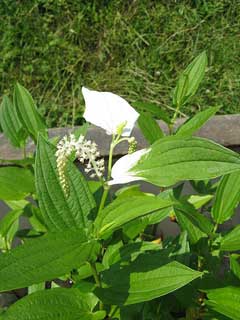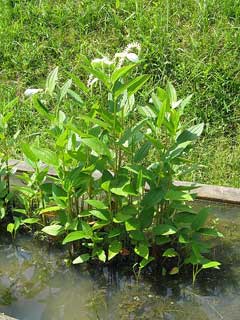 |
|
http://commons.wikimedia.org/wiki/User:KENPEI |
 |
| http://commons.wikimedia.org/wiki/User:KENPEI |
Translate this page:
Summary
Physical Characteristics

 Saururus chinensis is a PERENNIAL growing to 1.2 m (4ft).
Saururus chinensis is a PERENNIAL growing to 1.2 m (4ft).
See above for USDA hardiness. It is hardy to UK zone 6. It is in flower from August to September. The species is hermaphrodite (has both male and female organs).
Suitable for: light (sandy), medium (loamy) and heavy (clay) soils. Suitable pH: mildly acid, neutral and basic (mildly alkaline) soils. It can grow in semi-shade (light woodland) or no shade. It prefers wet soil and can grow in water.
UK Hardiness Map
US Hardiness Map
Synonyms
S. loureier.
Plant Habitats
Woodland Garden Dappled Shade; Shady Edge; Pond; Bog Garden;
Edible Uses
References More on Edible Uses
Medicinal Uses
Plants For A Future can not take any responsibility for any adverse effects from the use of plants. Always seek advice from a professional before using a plant medicinally.
Antiperiodic Antiphlogistic Depurative Diuretic Febrifuge Laxative Malaria Parasiticide
Poultice Urinary
Antiperiodic, parasiticide[61, 178]. The flowers are antimalarial, diuretic, eliminative, laxative and parasiticide[218]. The root is antimalarial, depurative, eliminative and parasiticide[218]. The whole plant is antiphlogistic, depurative, diuretic, febrifuge and refrigerant[147, 218]. A decoction is used in the treatment of oedema, nephritis-associated oedema, nutritional oedema, inflammatory conditions and calculus of the urinary system, rheumatoid arthritis, boils and abscesses, rashes and fungal infections of the skin[147]. The leaves are used as a poultice to clean abscesses and boils[147, 218].
References More on Medicinal Uses
The Bookshop: Edible Plant Books
Our Latest books on Perennial Plants For Food Forests and Permaculture Gardens in paperback or digital formats.

Edible Tropical Plants
Food Forest Plants for Hotter Conditions: 250+ Plants For Tropical Food Forests & Permaculture Gardens.
More

Edible Temperate Plants
Plants for Your Food Forest: 500 Plants for Temperate Food Forests & Permaculture Gardens.
More

More Books
PFAF have eight books available in paperback and digital formats. Browse the shop for more information.
Shop Now
Other Uses
References More on Other Uses
Cultivation details
This is a plant for a boggy area of the garden, it is able to withstand temporary flooding[56]. It prefers a loamy soil[1] growing well in pond margins though it spreads vigorously[56]. It can succeed in damp sites in the woodland as well as in the bog garden[200]. Plants are fairly cold tolerant, but are best given a protective mulch in the winter[56].
References Carbon Farming Information and Carbon Sequestration Information
Temperature Converter
Type a value in the Celsius field to convert the value to Fahrenheit:
Fahrenheit:
The PFAF Bookshop
Plants For A Future have a number of books available in paperback and digital form. Book titles include Edible Plants, Edible Perennials, Edible Trees,Edible Shrubs, Woodland Gardening, and Temperate Food Forest Plants. Our new book is Food Forest Plants For Hotter Conditions (Tropical and Sub-Tropical).
Shop Now
Plant Propagation
Seed - best sown in a cold frame as soon as it is ripe in early autumn. Sow stored seed in late winter or early spring. Keep the pots moist by standing them in shallow water[200]. Prick out the seedlings into individual pots when they are large enough to handle and plant them out in the summer. Division in spring[1, 200]. The plants spread freely and division is possible at almost any time in the growing season. Divisions taken in mid to late summer should be overwintered in pots in a cold frame and then be planted out in late spring. Regular division maintains the vigour of the plant[200].
Other Names
If available other names are mentioned here
Native Plant Search
Search over 900 plants ideal for food forests and permaculture gardens. Filter to search native plants to your area. The plants selected are the plants in our book 'Plants For Your Food Forest: 500 Plants for Temperate Food Forests and Permaculture Gardens, as well as plants chosen for our forthcoming related books for Tropical/Hot Wet Climates and Mediterranean/Hot Dry Climates. Native Plant Search
Found In
Countries where the plant has been found are listed here if the information is available
Weed Potential
Right plant wrong place. We are currently updating this section.
Please note that a plant may be invasive in one area but may not in your area so it’s worth checking.
Conservation Status
IUCN Red List of Threatened Plants Status :

Growth: S = slow M = medium F = fast. Soil: L = light (sandy) M = medium H = heavy (clay). pH: A = acid N = neutral B = basic (alkaline). Shade: F = full shade S = semi-shade N = no shade. Moisture: D = dry M = Moist We = wet Wa = water.

Expert comment
Author
(Lour.)Baill.
Botanical References
58200266
Links / References
For a list of references used on this page please go here
Readers comment
| Add a comment |
|
If you have important information about this plant that may help other users please add a comment or link below. Only comments or links that are felt to be directly relevant to a plant will be included. If you think a comment/link or information contained on this page is inaccurate or misleading we would welcome your feedback at [email protected]. If you have questions about a plant please use the Forum on this website as we do not have the resources to answer questions ourselves.
* Please note: the comments by website users are not necessarily those held by PFAF and may give misleading or inaccurate information.
To leave a comment please Register or login here All comments need to be approved so will not appear immediately.
|
Subject : Saururus chinensis
|
|
|
|